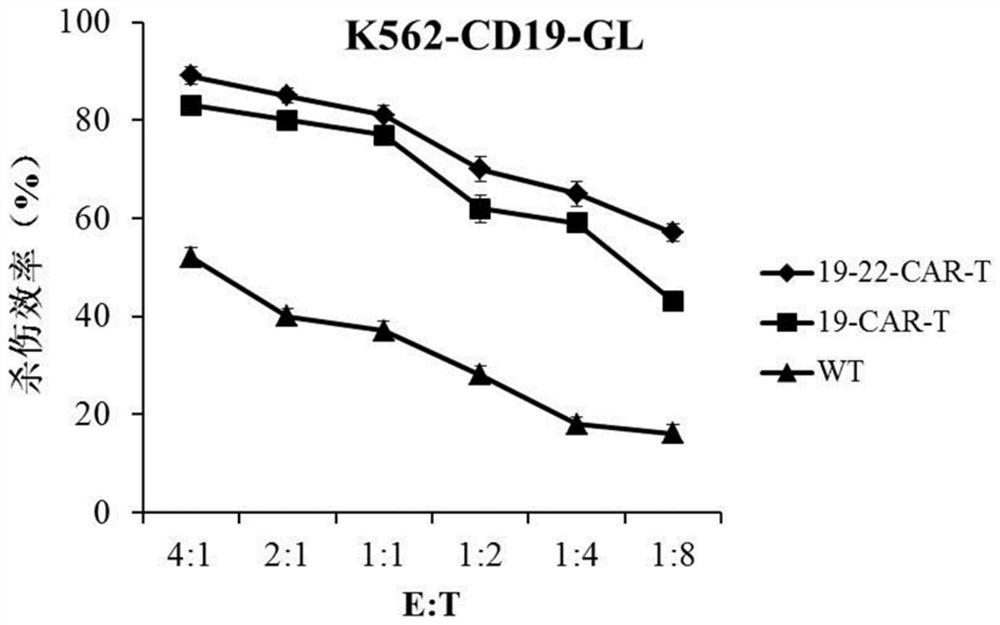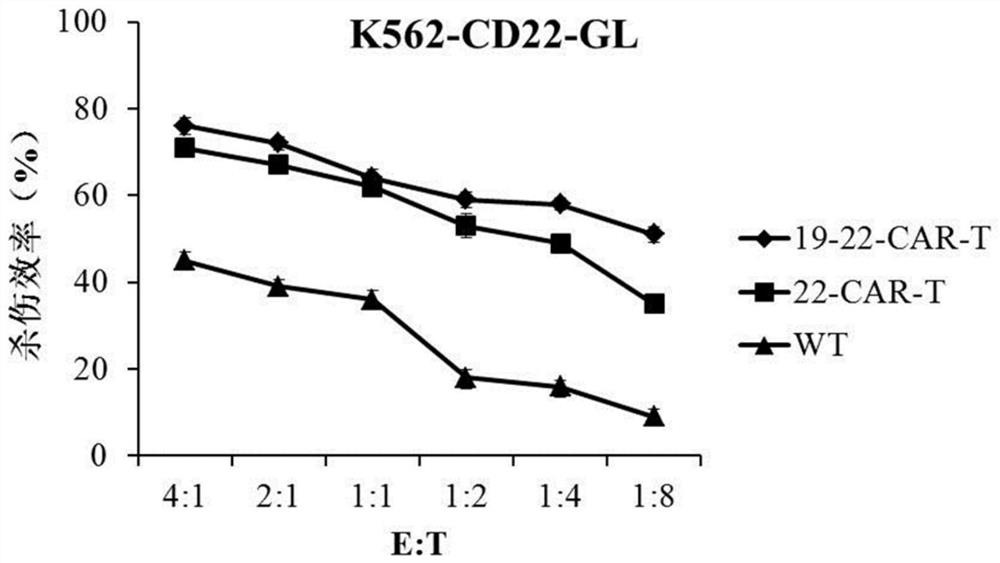CD19 and CD22 double-target chimeric antigen receptor T cell and application thereof
A technology of chimeric antigen receptor and CD22, which is applied in the field of biomedicine, can solve the problems of patient tumor recurrence and poor treatment effect of CAR-T cells, and achieve high-efficiency targeting effect, high-efficiency targeting activity and killing ability, and avoid The effect of immune escape
- Summary
- Abstract
- Description
- Claims
- Application Information
AI Technical Summary
Problems solved by technology
Method used
Image
Examples
Embodiment 1
[0045] Example 1 Construction of CAR Molecular Carrier
[0046] In this embodiment, the coding gene (SEQ ID NO: 4) of the anti-CD19 and CD22 dual-target chimeric antigen receptor is firstly synthesized, and the restriction endonuclease Pme1 restriction site is added to the C-terminal and N-terminal of the coding gene respectively and its protective base and restriction endonuclease Spe1 restriction site and its protective base;
[0047] The coding gene was double-digested with restriction endonucleases Pme1 and Spe1, and the digested product containing cohesive ends was recovered by agar gel electrophoresis, and then ligated into the linearized pWPXLd-eGFP plasmid (containing sticky end), the ligation reaction was carried out with the participation of T4 DNA polymerase (Invitrogent), and a lentiviral vector containing the coding gene of CAR targeting CD19 and CD22 dual targets was obtained.
[0048] In this example, CARs with antigen-binding domains of anti-CD19 scFv and CARs w...
Embodiment 2
[0049] Example 2 lentiviral packaging
[0050] In this example, the lentiviral vector constructed in Example 1 is used for lentiviral packaging, using a four-plasmid system, and the steps are as follows:
[0051] Mix the helper plasmids gag / pol, Rev and VSV-G with the recombinant vector in proportion, add it to a certain volume of serum-free DMEM, mix it and let it stand for 15 minutes; add the above mixture to the cell culture flask lined with 293T cells , mixed gently, at 37°C, 5% CO 2 Cultivate in the cell incubator for 6 hours; after 6 hours, replace the fresh medium, continue to cultivate, and add 10mM sodium butyrate solution; after 72 hours, collect the lentivirus culture supernatant for purification and detection.
[0052] Recombinant vectors include lentiviral vectors containing genes encoding CARs targeting both CD19 and CD22, lentiviral vectors containing genes encoding CARs targeting CD19 single targets, and lentiviral vectors containing genes encoding CARs target...
Embodiment 3
[0053] Example 3 Preparation of CAR-T cells
[0054] Peripheral blood mononuclear cells (PBMC) were separated from whole blood using Ficoll density gradient centrifugation kit (GE Company), and after red blood cells were removed, T cells were sorted out using MACS Pan-T magnetic beads;
[0055] The sorted T cells were diluted with medium (AIM-V medium + 5% FBS + penicillin 100 U / mL + streptomycin 0.1 mg / mL) to a cell concentration of 2.5×10 6 pcs / mL for use;
[0056] CD2 / CD3 / CD28 T cell activation expansion kit (Miltenyi Company) was used to activate T cells, that is, the coated magnetic beads were mixed with T cells at a ratio of 1:2, and the final density of T cells was 5×10 6 piece / mL / cm 2 , after mixing, place at 37°C, 5% CO 2 The incubator was stimulated for 48 hours;
[0057] After T cells were activated for 48 hours, demagnetize the beads, centrifuge at 300 g for 5 min, remove the supernatant, resuspend T cells with fresh medium, add recombinant lentivirus expressin...
PUM
 Login to View More
Login to View More Abstract
Description
Claims
Application Information
 Login to View More
Login to View More - R&D
- Intellectual Property
- Life Sciences
- Materials
- Tech Scout
- Unparalleled Data Quality
- Higher Quality Content
- 60% Fewer Hallucinations
Browse by: Latest US Patents, China's latest patents, Technical Efficacy Thesaurus, Application Domain, Technology Topic, Popular Technical Reports.
© 2025 PatSnap. All rights reserved.Legal|Privacy policy|Modern Slavery Act Transparency Statement|Sitemap|About US| Contact US: help@patsnap.com


